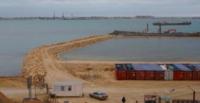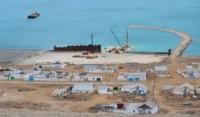You are here
History of port of Bautino.



The formation of sea route on Caspian Sea.
“The sea is not subject to despots. On the surface of the seas, they can still repair lawlessness, wage wars, kill their own kind. But at a depth of thirty feet under the water they are powerless, here their power ends!”
Jules Verne.
Sailing on Caspian Sea.
Western Kazakhstan was the first region annexed to the Russian Empire in the 30s. XVIII century. The Caspian littoral was considered by the tsarist government as an outpost for the conquest of Kazakh tribes and Turkmen who had not yet joined, for advancing to Khiva, Iran, Afghanistan, and India.
The most important strategic means for this were roads. After the accession of the Younger Zhuz to the Russian Empire, the tsarist government faced the question of developing existing means of communication and building new ones.
The region already had ancient caravan roads that passed through the steppe or the Caspian Sea. But the completion of accession of Kazakhstan in the 60s. The nineteenth century, which coincided with the beginning of the industrial revolution and the rapid development of capitalism in Russia, urgently demanded a solution to the question of a wider choice of ways and means of communication with the region.
Even before the construction of railways here, preference was given to the sea route through the Caspian Sea. The Caspian Sea has long played an outstanding role in Russia's relations with Central Asia. The eastern seashore was investigated in detail by P. S. Karelin.
He and Colonel Mansurov in 1831 laid down a fortress in the Kaydak Bay - the Novo-Aleksandrovsky fortification. The area for the Novo-Aleksandrovsky fortification was chosen poorly. Diseases raged in the garrison, especially scurvy.
Therefore, in 1846, the fortification from Kaydak Bay was transferred to a healthy area on Mangyshlak - to Cape Tyub-Karagan. In 1857, the fortification was renamed Fort Alexander. The importance of the Fort Alexander Bay and Tyub-Karagan Bay increased over time due to the development of fishing off the eastern shores of the Caspian Sea and the development of commodity exchange in European Russia and the Caucasus with Turkestan, Persia, and Afghanistan, which caused a strong recovery in shipping on the Caspian Sea.
Cargo and passenger communications were supported by large boats, sailing and steam vessels of private individuals or by ship flights of the Kavkaz and Mercury, Vostochnoe and Samolet societies. Despite the construction of the Orenburg-Tashkent railway and, in connection with this, the diversion of part of the cargo, shipping on the Caspian Sea continued to develop, as Russia's trade relations with Central Asia, Iran and other eastern countries expanded.
The Caspian Sea from the second half of the nineteenth century. considered by Russia as an option for a more convenient, safe and cheap trade route. By the end of the nineteenth century. several ports already existed on the Caspian Sea: Astrakhan, Krasnovodsk, Fort Petrovsk, Derbent, Baku.
The importance of Fort Alexandrovsky grew in this regard. By 1890, there were 39 people in it, conducting not only local barter, but also foreign trade, of which 22 had their own sea-going vessels - salvage ships, pods, booms.
The largest merchant and shipowner, conducting independent trade, as well as the transport of goods and passengers on their ships, was Zakhar Dubsky. From Fort Aleksandrovsky to Baku, Astrakhan, Petrovsk exported goods of local production or brought from Khiva.
They mainly exported sturgeon fish, pack caviar, lamb, camel hair, sheepskin, meat and livestock, imported rye and wheat flour, millet, barley, spirits, seedlings, hay, oats, kerosene, firewood and forest material, horses , groceries and manufactured goods, etc.
The largest campaigns that carried out both freight and passenger transportation along the Caspian Sea, by the beginning of the twentieth century. became the shipping company “Caucasus and Mercury”, the board of which was in St. Petersburg, and the main office was in Astrakhan (the steamships Kolomnya, Mikhail, Georgiy Pobedonosets, etc. were transported); Commodity and Passenger Joint-Stock Company “Airplane”, which transported throughout the Caspian Sea and the river. Volga.
The society owned the schooners “Asan Dadeshev”, “Alekber”, “Kulam Mirza” and others. In 1913, the Caucasus and Mercury society, the ship owner Zorin, were provided with lease coastal plots in Tyub-Karagan Bay to build their own marinas.
The northern coast of the Caspian Sea is characterized by shallow water, therefore, from the mouth of the river. The Urals up to the Tyub-Karagan Bay do not have a good harbor, and navigation in this part of the sea was poorly developed almost until the beginning of the 20th century.
By 1960, one of the largest enterprises in Mangistau was the commercial sea port of Bautino, located in the Tyub-Karagan bay of the Caspian Sea. It was formed by order of the Minister of the Navy of the USSR of January 8, 1960 with subordination to the Astrakhan Department of the Sea Fleet of the Caspian Shipping Company of the Ministry of the Sea Fleet of the USSR (the port began its activities on August 29, 1928 under the name Fort Alexander.
Sea Agency of the Makhachkala Port Authority, subordinate to the People’s Commissar of the USSR By 1960, the economy of the Shevchenkovsky district of the Guryev region was limited mainly to the local industry that produces building materials, during which years oil and gas exploration was carried out, which shared the prospects for the development of the region as a whole and the Bautino seaport in particular.
It was through its berths that it was supposed to let the entire cargo flow connected with the production of exploration, construction works, export of products, import of products and materials of industry for future construction. In this regard, the Ministry of the Navy decided the question of creating an independent commercial sea port on the Mangyshlak Peninsula with two assigned port points: Sarytash and Aktau. In the early 60's in reality, only the Sarytash port was operating, and construction work was carried out in the Aktau port.
The Bautino Commercial Sea Port, reorganized from the Bautino Port Point, began operating on May 15, 1960. In view of the volumes of cargo handling and processing established for the port and its equipping with mechanization facilities, the port was assigned III category.
By that time, there were two berths in Bautino and one berth in the port of Sarytash in the Bautino seaport. The main berth of the port had a mooring line of 75 m, which allowed only one vessel to be handled. There was a covered cargo warehouse on this pier.
However, its area was clearly insufficient for all cargo entering the port and requiring storage in closed warehouses. The open warehouse area also did not allow storing and storing cargo arriving simultaneously at the port. The second pier of the port was a flooded barge and was used exclusively for loading sawn stone.
The available warehouse open area made it possible to procure cargo during the inter-navigation period. On this pier, the port could not carry out cargo operations with other goods due to poor access roads, as well as the lack of storage facilities.
In the port of Sarytash there was a wooden pile pier, which made it possible to simultaneously install and process four barges. One of the significant shortcomings in the work of the port of Bautino and the port of Sarytash was the insufficient depth both at the berths and at the approach routes and channels.
So, during the navigation of 1960, there were repeatedly cases of landing of ships aground at the berths.
Of the main cargoes brought to Mangyshlak through the port of Bautino, about half - 45 - 50% - was fresh water for the needs of the population; petroleum products - 20%; forest materials - 8 - 10%, flour and food products - 7 - 8%, coal - 3 - 4% and other cargoes. In the 60s.
The volume of processing of the most important economic cargoes in the port in connection with the development of the region’s economy was constantly increasing, however, the port experienced a number of difficulties associated with the lack of equipment, especially crane, as well as with the state of the marina and storage facilities.
The number of berths, and especially their length, and the suitable depths in their area did not allow receiving more than one vessel and vessels with a large draft. The port with personnel experienced great difficulties.
The port could not immediately pick up qualified personnel, and the training of the newly hired was hampered by the lack of engineering workers. “In the port, the average annual number of workers was 37 people, that is, at the plan level.
However... such a number of movers is clearly not enough - it is necessary to have at least 60 movers in Bautino and at least 20 - 25 people in Sarytash (referring only to the navigation period) for the simultaneous processing of four vessels that rely on the norm in Bautino and Sarytash.
”But to provide the necessary number of workers was not possible. The port attracted loaders from the cities of Guryev and Astrakhan. The high turnover of port workers was associated with heavy physical labor, high ambient temperatures, insufficient port housing, and a lack of living conditions.
At the end of the 60s In the port of Bautino a passenger berth of a pile type was built, separated from the cargo and with a separate exit. In the summer of 1968, dredging was carried out in the port's water area, approaches to all berths were deepened to 5 m.
At the same time, a number of measures were taken in the port to improve the life of port workers and employees: overhaul and conversion of the building into a store were carried out on the quays of Atash villages and Bautino change houses were built, due to the difficult situation with water, a drinking water tank was installed.
In 1967, the port of Sarytash was liquidated. Later, the Bautin seaport contributed to the equipment of a reinforced concrete pier in the city of Astrakhan. Sam then The International Maritime Transport Company, the Bautino seaport, entered it as a structural unit.
Currently, in connection with the rapid development of the natural resources of the region, especially oil, the development of shipping in the Caspian is receiving a new impetus. Sea transport is becoming one of the important means of transporting oil and other goods, as well as one of the international vehicles.
List of references:
1. Materials on the issue of trade routes to Central Asia. - St. Petersburg, 1869 .-- S. 40.
2. Information about the merchants at Fort Alexandrovsky from January 1, 1889 to January 1, 1890
3. Central Administration of the Republic of Kazakhstan. F. 40, op. 1, d. 213, l. 70–78.
4. TsGA RK. F. 40, op. 1, d. 212, d. 370, d. 656, d. 755.
5. Copies of the attitude of the Office of the Head of the Trans-Caspian Region dated January 7, 1913 No. 433 to the Head of Mangyshlak Uyezd // Central Administration of the Republic of Kazakhstan. F. 807,
p. 1, d. 1, l. 9.
6. GAMO. Explanatory note to the fund 123. Bautinsky Commercial Sea Port.
7. GAMO. F. 123, op. 1, d.8, l. 46, l 145.
8. The history of the development of transport and communications of Kazakhstan / Comp. N.F. Piven, A.I. Shaltykov. - Almaty, 2000 .-- S. 18.
9. GAMO. F. 123, op. 1, d.14, l 141. 10. GAMO. F. 123, op. 1, d. 91, l. 57. 11. GAMO. F. 123, op. 1, d. 53, l. 5.
Authority:
M. W. Nursultan. "Formation of the sea route on the Caspian Sea." 02/07/2008. http://vestnik.astu.org/content/userimages/file/gen_2008_2_43/52.pdf
Photos
Alexander Petrov.







